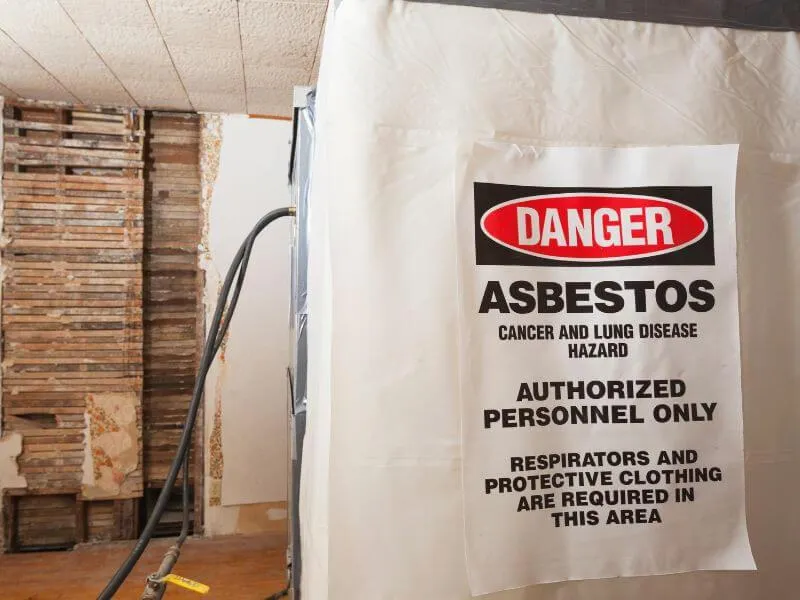
Learn About Asbestos: Health Risks and the Risk of Exposure
Discover the Essentials About Asbestos: What Is Asbestos and Why Should You Be Cautious About It?
Asbestos is a natural mineral that has been widely used in various asbestos products due to its fire-resistant properties. However, the use of asbestos poses significant health risks. When materials containing asbestos are disturbed, they can release asbestos fibers into the air, which can be inhaled. The most dangerous forms of asbestos include blue asbestos and brown asbestos, both of which are known to cause severe health issues. Chrysotile asbestos, the most commonly used type, can still be found in many older buildings, including floor tiles and asbestos cement products. Long-term exposure to high levels of asbestos fibers in the air can lead to serious conditions, including lung cancer and mesothelioma, resulting in symptoms such as shortness of breath.
Asbestos is often found in asbestos materials that were commonly used in construction and manufacturing. The agency for toxic substances warns that even small amounts of asbestos can be harmful, especially when disturbed during renovations. Homeowners should learn how exposure to asbestos can occur and be aware of the signs of asbestos contamination. If asbestos is suspected in a property, it is crucial to remove asbestos safely and consult professionals who specialize in handling asbestos. Proper safety measures are essential to mitigate the health hazards associated with this dangerous material, ensuring that asbestos fibers do not become airborne during the removal process.
What is Asbestos Exposure?
So, let’s break down what asbestos exposure really means. Basically, asbestos is a mineral that was super popular in the past because it was used in all sorts of products containing asbestos, like insulation and floor tiles. But here’s the kicker: when you mess with these materials, they can release tiny asbestos fibers into the air. If you accidentally breathe in asbestos fibers, you’re at a higher risk of developing some serious health issues. Even today, some older buildings and products still contain asbestos that could be harmful. You’ve got to be cautious about whether a material contains asbestos or not, especially if it’s something you’re planning to renovate or demolish.
Now, let’s talk about the long game. Long-term exposure to asbestos can lead to conditions like asbestosis or even lung cancer. That’s why folks who specialize in asbestos management, like licensed asbestos contractors, are so important. They focus on asbestos abatement to make sure any material that could contain asbestos is handled safely. If you’re involved in any work that could stir up asbestos that could be inhaled, it’s vital to follow occupational safety and health guidelines to keep everyone safe. So stay informed and be careful!
What are the types of asbestos?
So, let’s chat about the different types of asbestos out there. You’ve probably heard about how asbestos was used in tons of products, right? Well, there are mainly two types: chrysotile, which is the most common, and the amphibole group, which includes crocidolite and amosite. When you’re mining asbestos, you’re digging up these fibers that, when disturbed, get released into the air. That’s when the trouble starts! Inhaling asbestos fibers can lead to some serious health issues. Even secondhand exposure can be risky—like, if someone brings home that nasty asbestos dust on their clothes, you’re not safe either.
The real kicker is that asbestos exposure can take years to show any symptoms, so you might not even know you’re affected. Asbestos fibers can cause lung diseases and cancers, and the greater the exposure, the higher the risk. If you ever need to deal with it, the removal of asbestos should be done by professionals to avoid exposure to asbestos fibers. Seriously, it’s not something to mess around with!
And let’s not forget about local asbestos regulations—there are rules in place to help protect people from asbestos and asbestos related risks. If you’re in an old building, you might also find asbestos lurking in places you wouldn’t expect. Just remember, the types of asbestos cause different levels of risk, and if you think you’ve been exposed, it’s best to get checked out. Stay safe!
How does exposure to asbestos occur?
So, let’s break down how folks get exposed to asbestos. First off, this stuff was super popular back in the day, especially in construction and insulation materials. If you’re tearing down an old building or doing some renovations, you might kick up some asbestos fibers that have been chilling there for decades. Not cool, right?
Then there’s the whole thing with working in certain jobs. People in industries like shipbuilding, auto repair, or even in some factories might come into contact with asbestos without even realizing it. They could be handling materials that contain it or just breathing in those pesky fibers floating around.
Even home renovations can be a sneaky way to get exposed. If you’ve got an older house, there’s a chance some of the materials could have asbestos lurking in them. Always better to play it safe and get it checked out before diving into any projects!
What products commonly contain asbestos?
Hey there! So, you might be wondering what everyday stuff could actually have asbestos lurking in it. Believe it or not, it's not just some old buildings or vintage stuff. Back in the day, a ton of products used asbestos because it was great for fire resistance. Think of things like insulation, which was packed full of the stuff to keep homes cozy and safe.
Then there’s floor tiles and even some types of ceiling tiles. They often contained asbestos for that added durability and style. And don’t forget about some automotive parts, like brake pads and clutches. Seriously, who knew your car could be hiding such secrets, right?
Even some older textiles and fireproof clothing had asbestos woven into them. It’s wild to think about how common this stuff was! So, if you’re digging into some old stuff, better check for asbestos before you get too cozy with it!
How Can You Find Asbestos in Your Home?
So, you’re wondering how to find asbestos in your home? First off, it’s important to know that asbestos was commonly used in building materials like insulation, flooring, and roofing. If your place was built before the 1980s, there’s a good chance you might find large amounts of asbestos lurking around. Check for materials that look old or damaged; they might be protected with asbestos paper. Also, remember that asbestos fibers may be released into the air if these materials are disturbed, which can lead to serious health issues.
Long-term asbestos exposure and related health problems can be a real concern. If you’re exposed to amphibole asbestos, it’s even worse, as it increases the risk of developing lung cancer and diseases like mesothelioma, which is a cancer linked to asbestos. Symptoms can take a long time to show up, so if you think you’ve been exposed, it’s smart to get a check-up. Just keep in mind that asbestos may still be hiding in places you wouldn’t expect!
What materials in your home may contain asbestos?
Hey there! So, if you're chilling at home, you might wanna know that some stuff around you could be related to asbestos. It was widely used in manufacturing a bunch of products back in the day, especially in things like insulation, flooring, and roofing materials. If your place was built before the '80s, there's a chance that those materials could still be lurking around. You see, asbestos increases the risk of some serious health issues, and exposure may lead to conditions like mesothelioma, which is a cancer that hits the lungs hard. And let’s be real, nobody wants to deal with those symptoms and diagnosis later on!
Even though it’s banned in many places now, asbestos still pops up in older homes. If you’ve got popcorn ceilings or old tiles, you might want to check them out because they could be previously used in products containing asbestos. Just a heads-up: if you suspect anything, it’s best to get a pro to take a look. Your health is way too important to gamble with!
How to identify asbestos insulation?
If you’re digging around in an old house, you might come across some funky-looking insulation. Now, you gotta be careful because that might be caused by asbestos. It was a popular material back in the day, and it’s often found in homes built before the 1980s. So, if you see something that looks like fluffy cotton candy or gray, crumbling stuff, it could be the real deal.
Now, you might not think much of it, but here’s the kicker: exposure to asbestos can lead to some serious issues, and we’re talking about stuff like mesothelioma is a cancer that can hit you years down the line. Make sure to check for signs of damage or wear and tear because that’s when the potential health risks really spike. Better safe than sorry, right? Always get a pro to check it out if you’re unsure!
When should you hire an asbestos professional?
If you’ve got an older home or building, you might be wondering when it’s time to call in an asbestos pro. Honestly, if you suspect there’s any chance of asbestos exposure, don’t mess around. It’s better to be safe than sorry! Those pesky fibers can cause some serious health effects, and nobody wants to deal with that.
So, if you see crumbling insulation or your popcorn ceilings are starting to look a little too vintage, it’s definitely a good idea to get an expert’s opinion. They can give you the lowdown on the health effects of asbestos exposure and help you figure out if you need to take action.
Plus, if you’re planning any renovations, make sure to get a professional in before you start swinging hammers. You want to avoid accidentally kicking up those harmful fibers and putting yourself and your loved ones at risk.
What Are the Risks of Asbestos Exposure in the Workplace?
Alright, let’s talk about something that’s been a big deal for a while—exposure to asbestos. If you’ve ever worked in construction or older buildings, you might have come across this stuff. The risks of asbestos-related illnesses are no joke! Breathing in those tiny fibers can lead to some serious health issues down the line, like lung cancer or mesothelioma.
And it’s not just a one-time thing; even short-term exposure can mess you up. So, if you think you’re in a safe zone at your job, think again! Many people don’t even realize they’re at risk until it’s too late. Regular check-ups and awareness are crucial, so make sure you’re looking out for yourself and your coworkers when it comes to asbestos safety.
Which occupations are most at risk for asbestos exposure?
So, let's talk about the jobs where folks are most likely to run into asbestos. It’s a sneaky little mineral that used to be super popular in construction and manufacturing. If you're working in construction, especially if you're tearing down old buildings or doing renovations, you really gotta watch out. Those old pipes and insulation can be loaded with the stuff!
Then there are the shipyard workers. They deal with a ton of materials that might have asbestos in them because ships used to be built with it to withstand high heat. And don't forget about automotive mechanics. They often handle brake pads and clutches that could contain asbestos too. So, if you're in any of these gigs, definitely keep your eyes peeled and make sure you're taking the right precautions!
How to mitigate the risk of exposure in the workplace?
Alright, so when it comes to mitigating the risk of exposure in the workplace, it’s all about keeping things chill and safe. First off, you really gotta get everyone on the same page. Make sure your crew knows about the risks and what they can do to stay safe. Regular training sessions and simple reminders can go a long way!
Next up, don’t underestimate the power of PPE (personal protective equipment). Whether it’s gloves, masks, or goggles, having the right gear is a must. And hey, it’s not just about having it; you’ve got to make sure everyone actually uses it!
Lastly, keep the place clean and organized. A tidy workspace helps reduce accidents and makes it easier to spot any potential hazards. So, a little bit of teamwork and mindfulness can really help in keeping everyone safe and sound!
What Is Involved in Asbestos Removal?
So, you’ve got some old building materials that might contain asbestos? First things first, you’ll want to call in the pros because handling that stuff is no joke. They’ll usually start with a thorough inspection to figure out where the asbestos is hiding and what kind it is. Seriously, it’s like a treasure hunt, but way more dangerous!
Once they’ve pinpointed the problem areas, they’ll gear up in some serious protective gear—think hazmat suits and respirators. Safety is key here! After that, the actual removal process begins, which can involve sealing off the area and using special tools to carefully take out the asbestos without releasing any nasty fibers into the air.
Finally, once everything’s cleared, they’ll dispose of the asbestos in a proper way. It’s a big deal, but totally necessary if you want to keep your space safe and sound!
How is asbestos removal conducted?
So, when it comes to asbestos removal, it’s not just a DIY weekend project. First off, you gotta call in the pros—these guys are certified and trained to handle the stuff safely. They’ll come to your place, do a thorough inspection, and identify where that pesky asbestos is hiding.
Once they’ve got a plan, they’ll set up a containment area to make sure none of those nasty fibers escape into the air. They typically use special tools and wear protective gear, kind of like they’re in a sci-fi movie or something!
Then comes the actual removal, which can get pretty messy. The pros will carefully take out the asbestos materials, seal them up, and dispose of them according to regulations. After that, they’ll do a thorough cleanup and might even do air quality tests to ensure everything’s safe. It’s a whole process, but totally worth it for a healthy home!
What should you know about asbestos removal professionals?
Asbestos removal professionals are the real deal when it comes to dealing with that nasty stuff. First off, you gotta make sure they’re certified and have the right training. It’s not just about having a truck and some tools; these folks need to know exactly what they’re doing to keep everyone safe.
Next up, check their experience. You want someone who’s been around the block a few times and knows the ins and outs of asbestos removal. Ask for references or read some reviews to see how they’ve handled previous jobs.
Oh, and don’t forget about the equipment they use! Proper gear is essential; they should have high-quality protective equipment and air filtration systems to keep the area safe while they work.
Lastly, get a clear idea of the cost and the timeline. You want to know what you’re getting into, so there are no surprises later on. Just keep these things in mind, and you’ll be golden!
What precautions are taken during asbestos removal?
So, when it comes to asbestos removal, there's a whole checklist of precautions that pros need to follow to keep everyone safe. First off, they usually start by sealing off the area with plastic sheeting to make sure those pesky fibers don’t escape into the air. It’s like putting the whole room in a giant plastic bubble!
Next, they’ll often use negative air pressure systems to ensure that any air that could potentially leak out is filtered. They want to catch all the bad stuff before it gets a chance to mingle with the fresh air. Plus, the team has to wear protective gear, like respirators and special suits, to keep themselves safe from inhaling anything harmful.
Finally, once the removal is done, everything has to be cleaned up properly, and the waste is disposed of in a way that meets regulatory standards. It’s a whole process, but it’s super important for health and safety!
If you're concerned about asbestos in your home or business, don't take risks with your safety. Contact Enviro Removal today for professional asbestos inspection, removal, and disposal services you can trust. With our commitment to quick response times, competitive pricing, and safe practices, we’re here to provide peace of mind and a healthier environment. Fill out our contact form or call us now to schedule your consultation—because your safety is our priority.

